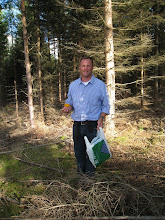
Since September I have been dumping a bushel of fresh grass clippings into the chicken pen whenever I mow. Our six chickens really like to eat the grass, pick through it, scratch, and generally play with it. They are especially happy when I dump a few handfuls of barley over the clippings so they can peck and scratch through the pile to get the barley.
Fall is here and there won't be any more mowing, so I have taken the last cutting of the year and am drying it (i.e., making it into hay) to keep for winter so I will have something to throw in to the chicken run and use for litter on the floor of the hen house. I am not sure that they will eat the dried grass, but it will still give them a change of pace and something different to scratch through.
I basically just let the lawn get pretty long (maybe six inches) then mowed with a push mower that catches the clippings in a bag. I usually use a riding mower and leave the clippings on the lawn. I filled about 16 mower bags with clippings -- about 10 bags the first time I cut and 6 bags the second time on a different part of the lawn about two days later -- and dumped them on the driveway to dry. I spread them out using a hoe so they are no more than 1-2 inches deep and there are spaces here and there.
Twice a day I used a leaf rake to "ted" the hay, (the act is called "tedding") which means I turned it over and fluffed it up to ensure it is drying evenly

throughout and there are no moist clumps that could mold. The best hay I have, which is grass collected from the middle of the yard, was basically dry in two days (sunny days, daytime/nighttime temps: 68/40 degrees). I left it out one more day just to make sure. The weather was predicted to stay dry.
The second time I cut grass for hay -- two days after the first -- I collected clippings closer to trees and got more leaves in the hay. The leaves were just starting to fall in earnest here the last week of October. The picture to the left shows grass cut 2 days apart (older, dryer grass on right). I think this grass/leaf mix (left) will be fine for litter in the coop. I am storing the hay in big plastic bins, pressed down as firmly as I can get it, in the garage.

I processed and stored a total of two large plastic containers of the first cutting of the hay. I pressed down as hard as I could with the flat part and then the end of a grain scoop shovel to try to pack the material as tightly as possible into the containers. Each container is roughly the size if a commercial bale of hay. I am sure my hay is not packed as tightly as a real bale, so my actual mass of hay is definitely not two bales -- maybe about one-half bale total. Writing this gives me the idea that I should weigh the hay. I plan to store the second cutting of hay later in the week. I am hoping for no rain because I will be out of town for a few days.
Above: The finished product: completely dry and ready to be stored and

used.
Hay being pressed into containers for storage in the garage. Unfinished (not quite dry yet) hay in background.























